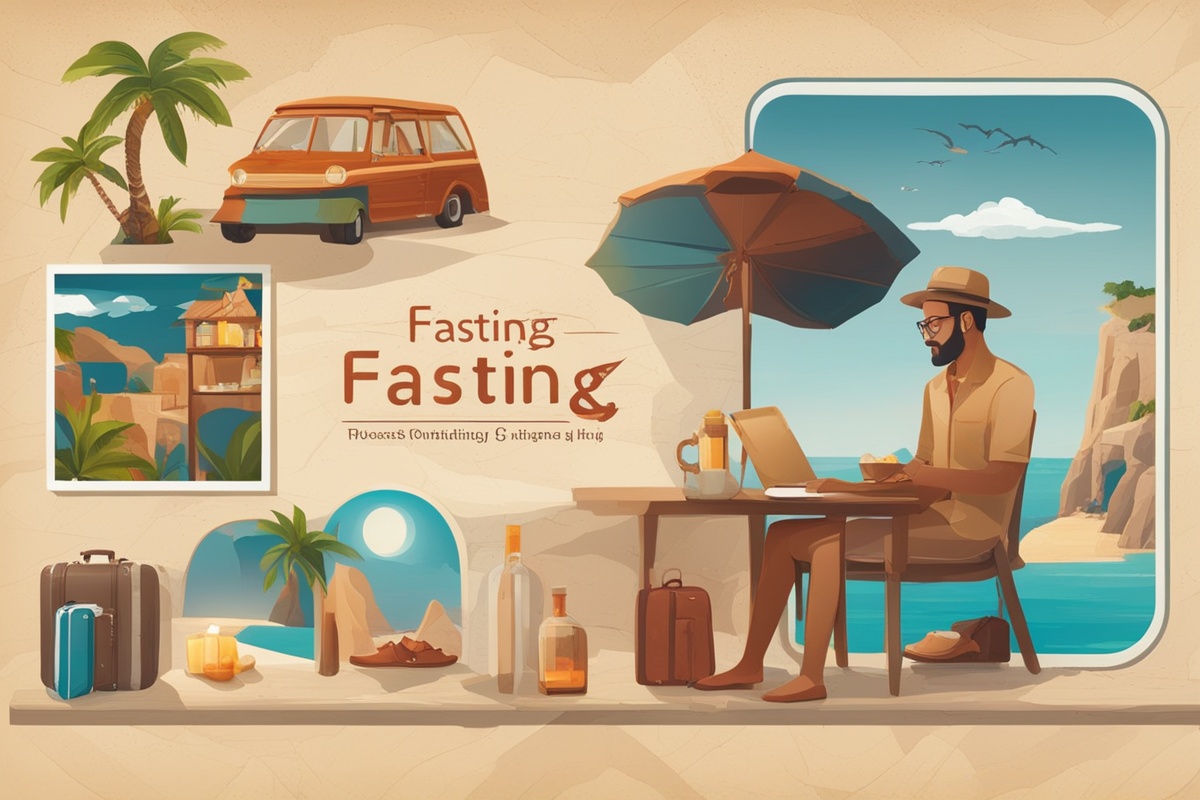Traveling is an exciting way to explore new cultures, unwind, or tackle business opportunities, but it can throw a wrench into your wellness routines—especially if you’re committed to health fasting. Whether you’re practicing intermittent fasting, extended fasting, or fasting for spiritual reasons, maintaining your fasting schedule on the road can feel daunting. Between jet lag, unpredictable meal times, and limited food options, it’s easy to slip off track. But don’t worry! I’ve been there, juggling fasting goals with packed travel itineraries, and I’m here to share actionable tips and science-backed insights to help you stay consistent with your fasting for health practices, no matter where your adventures take you. Let’s dive into how you can seamlessly blend fasting and travel while prioritizing your well-being.
Why Health Fasting Matters During Travel
Fasting, particularly intermittent fasting, has gained traction for its potential benefits like improved metabolic health, weight management, and even mental clarity (Mattson et al., 2017). When you’re traveling, maintaining these benefits can be a game-changer. Fasting can help regulate your energy levels, reduce bloating from irregular meals, and keep you focused despite the chaos of airports or long drives. However, travel often disrupts circadian rhythms, which can impact hunger hormones like ghrelin and leptin, making fasting feel harder (Chellappa et al., 2013). Understanding this connection is key to adapting your health fasting routine to new environments. Beyond the science, fasting during travel can also simplify logistics—fewer meals to plan means more time to enjoy your trip!
Challenges of Fasting While Traveling
Let’s be real: travel isn’t always fasting-friendly. Time zone changes can mess with your eating windows if you’re following a 16:8 intermittent fasting plan. Airport food courts often tempt with high-calorie, processed options that don’t align with fasting health benefits. Then there’s the social aspect—declining meals with friends or family during cultural experiences can feel awkward. Hydration, a cornerstone of safe fasting, can also be tricky when you’re stuck on a plane with limited water access or in a hot climate. Recognizing these hurdles upfront helps you prepare and stick to your healthy fasting goals without feeling overwhelmed.
Practical Tips for Successful Health Fasting on the Road
With a little planning, you can master health fasting while traveling. I’ve learned through trial and error what works, and I’m excited to pass these strategies on to you. Here are some practical ways to keep your fasting routine intact, no matter where you are:
- Plan Your Fasting Window Around Travel Schedules: If you’re flying across time zones, adjust your eating window to match your destination’s time as soon as possible. For example, if you’re on a red-eye flight, consider breaking your fast after landing to sync with local meal times.
- Pack Fasting-Friendly Snacks: Carry low-calorie, nutrient-dense options like nuts or electrolyte tablets for emergencies. These can tide you over if you need to extend a fast or if breaking it isn’t an option.
- Communicate Your Needs: If you’re traveling with others, let them know about your fasting goals. A simple “I’m skipping this meal for health reasons” can avoid misunderstandings.
- Research Ahead: Look up restaurants or grocery stores at your destination that offer fasting-compatible foods for when you break your fast. Apps like HappyCow or Yelp can be lifesavers.
Staying Hydrated and Energized During Fasting
Hydration is non-negotiable when it comes to fasting for health, especially during travel. Dehydration can worsen fatigue and hunger pangs, making fasting feel unbearable (Pross et al., 2014). Planes are notoriously dry environments, and long car rides or sightseeing can leave you parched if you’re not mindful. Plus, fasting already reduces water intake from food, so you need to be proactive. Sip water regularly, aim for at least 2–3 liters daily, and consider adding a pinch of salt to your water to replenish electrolytes, especially in hot climates. Black coffee or herbal teas (without sweeteners) can also keep you energized without breaking your fast (Anton et al., 2018). Just don’t overdo the caffeine—it can dehydrate you if consumed in excess.
Navigating Cultural and Social Expectations
One of the trickiest parts of combining healthy fasting with travel is handling social situations. Food is often central to cultural experiences—think shared meals in Italy or street food tours in Thailand. Declining food can sometimes be misinterpreted as rudeness, but there are ways to navigate this gracefully. I’ve found that honesty works best; explaining that you’re following a health fasting plan for personal reasons often garners respect. If fasting isn’t flexible (like during religious fasts), participate in the experience without eating—focus on the company or take small sips of water if offered. For intermittent fasters, try scheduling your eating window around group meals to join in without derailing your plan.
Health Precautions and Listening to Your Body
While fasting offers many fasting health benefits, it’s not a one-size-fits-all solution, especially during travel. Stress, lack of sleep, and physical exertion can amplify the risks of fasting, such as dizziness or low blood sugar (Johnstone, 2015). If you’re new to fasting or have underlying health conditions like diabetes, consult a healthcare provider before fasting on the go. Even seasoned fasters should stay attuned to their bodies. Feeling lightheaded or overly fatigued? It might be time to break your fast with a small, balanced meal. Here are some signs to watch for and actions to take:
- Extreme Fatigue: If you’re too tired to function, consider shortening your fast or eating a light snack rich in protein and healthy fats.
- Dizziness or Nausea: This could signal dehydration or low electrolytes. Drink water with a pinch of salt or an electrolyte solution immediately.
- Irritability: Often called “hanger,” this can worsen with travel stress. Take a break, rest, and reassess your fasting plan.
- Persistent Hunger: If hunger becomes unbearable, it’s okay to eat. fasting should support your health, not harm it.
- Medical History: If you’re on medication or have a chronic condition, prioritize safety over fasting—always check with your doctor first.
Travel already taxes your body, so don’t push yourself too hard. Fasting is a tool for wellness, not a punishment. Flexibility is your friend here—adjust as needed to maintain balance.
Conclusion
Blending health fasting with travel doesn’t have to be a struggle. With thoughtful preparation, an understanding of your body’s needs, and a willingness to adapt, you can reap the fasting health benefits while exploring the world. From syncing your fasting windows with new time zones to staying hydrated and navigating social meals, these strategies can help you stay on track without sacrificing the joy of travel. Remember, fasting is about enhancing your well-being, so listen to your body and prioritize health over rigid rules. Have you tried fasting while traveling? I’d love to hear your tips or challenges in the comments—let’s keep this conversation going and support each other on our healthy fasting journeys!
References
- Anton, S. D., Moehl, K., Donahoo, W. T., Marosi, K., Lee, S. A., Mainous, A. G., … & Mattson, M. P. (2018). Flipping the metabolic switch: Understanding and applying the health benefits of fasting. Obesity, 26(2), 254-268.
- Chellappa, S. L., Steiner, R., Oelhafen, P., & Cajochen, C. (2013). Acute exposure to evening blue-enriched light impacts on human sleep. Journal of Sleep Research, 22(5), 573-580.
- Johnstone, A. (2015). Fasting for weight loss: An effective strategy or latest dieting trend? International Journal of Obesity, 39(5), 727-733.
- Mattson, M. P., Longo, V. D., & Harvie, M. (2017). Impact of intermittent fasting on health and disease processes. Ageing Research Reviews, 39, 46-58.
- Pross, N., Demazières, A., Girard, N., Barnouin, R., Metzger, D., Klein, A., … & Guelinckx, I. (2014). Effects of changes in water intake on mood of high and low drinkers. PLoS One, 9(4), e94754.






